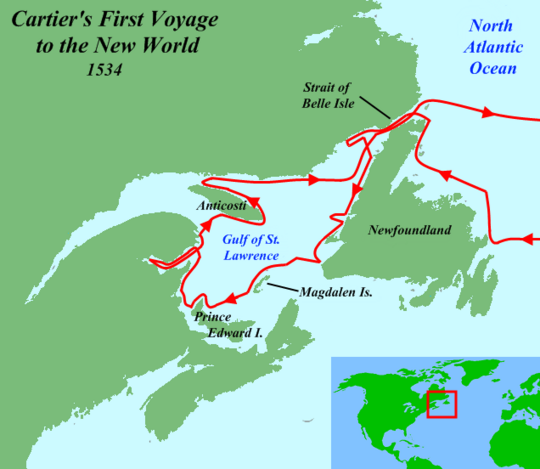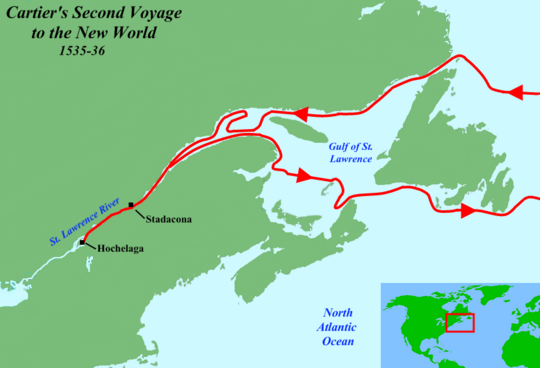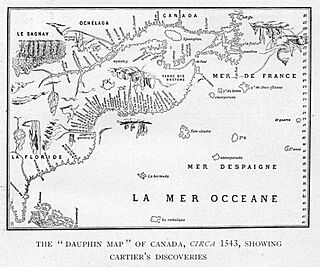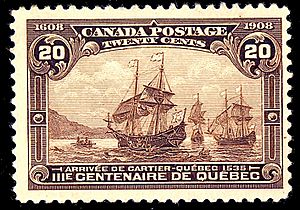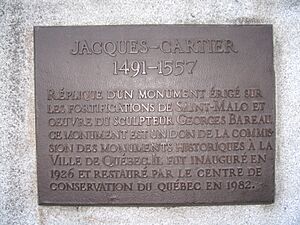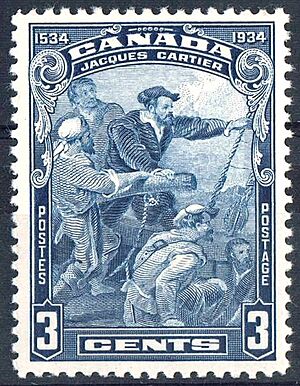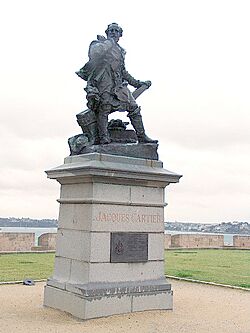Jacques Cartier facts for kids
Quick facts for kids
Jacques Cartier
|
|
|---|---|
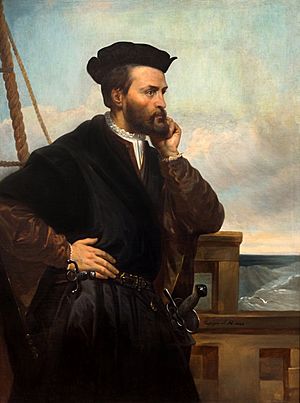
Portrait by Théophile Hamel, c. 1844. No contemporary portraits of Cartier are known.
|
|
| Born | 31 December 1491 Saint-Malo, Duchy of Brittany
|
| Died | 1 September 1557 (aged 65) Saint-Malo, France
|
| Nationality | French |
| Occupation | Navigator and explorer |
| Known for | First European to travel inland in North America. Claimed what is now known as Canada for the Kingdom of France. |
| Spouse(s) |
Mary Catherine des Granches
(m. 1520) |
| Signature | |
 |
|
Jacques Cartier (born December 31, 1491 – died September 1, 1557) was a famous French maritime explorer from Brittany. He was the first European to explore and map the Gulf of Saint Lawrence and the shores of the Saint Lawrence River. He named this area "The Country of Canadas" after the local Iroquoian names for the large settlements he saw at Stadacona (now Quebec City) and Hochelaga (now Montreal Island).
Cartier created maps and wrote accounts of his journeys, even though these are now lost. He was the first European to describe and name this region and its people. This happened at a time when the Spanish had already settled in the Caribbean, Mexico, and Central America. They were also beginning their conquest of Peru.
Contents
Early Life of Jacques Cartier
Jacques Cartier was born in 1491 in Saint-Malo, a port city on the northeast coast of Brittany. He was a respected mariner. In 1520, he married Mary Catherine des Granches, who came from an important family. This helped improve his social standing. His good reputation in Saint-Malo is clear because his name often appears in baptism records as a godfather or witness.
First Voyage to North America (1534)
In 1534, King Francis I of France asked Cartier to explore new lands. The King had previously sent another explorer, Giovanni da Verrazzano, to explore North America's eastern coast. Cartier was known for his sailing skills, having traveled to Newfoundland and Brazil.
On April 20, 1534, Cartier set sail with the King's permission. He hoped to find a western route to the rich markets of Asia. His mission was to "discover certain islands and lands where it is said that a great quantity of gold and other precious things are to be found."
The journey across the ocean took twenty days. Starting on May 10, he explored parts of Newfoundland and the Strait of Belle Isle. He also explored the southern shore of the Labrador Peninsula and the coastlines of the Gaspé Peninsula and North Shore in the Gulf of St. Lawrence. He visited some of the Gulf's main islands, including Prince Edward Island, Anticosti Island, and the Magdalen Islands. During one stop, his crew took about 1000 birds, mostly great auks, which are now extinct.
Cartier met aboriginal peoples in Canada twice on the north side of Chaleur Bay, likely the Mi'kmaq. These meetings were short, and some trading happened.
His third meeting was with St. Lawrence Iroquoians in Gaspé Bay. On July 24, he planted a 10-meter cross there, claiming the land for France. The cross said, "Long Live the King of France." The Iroquoians understood what Cartier was doing. Here, he took the two sons of their chief, Donnacona, with him. Cartier wrote that they told him this region was called Honguedo. The chief eventually agreed to let them go, as long as they returned with European goods for trade.
Cartier returned to France in September 1534. He was sure he had reached a part of Asia.
Second Voyage and Winter in Canada (1535–1536)
Jacques Cartier began his second voyage on May 19 of the next year. He had three ships, 110 men, and the two Iroquoian captives from his first trip. He sailed up the St. Lawrence River for the first time. He reached the Iroquoian capital of Stadacona, where Chief Donnacona lived.
Cartier left his main ships near Stadacona. He used his smallest ship to continue to Hochelaga (now Montreal), arriving on October 2, 1535. Hochelaga was much larger and more impressive than Stadacona. Over a thousand people came to the river's edge to greet the Frenchmen. The expedition could not go further because rapids blocked the river. Cartier was so sure this river was the Northwest Passage to China that the rapids and the town that grew nearby were named after the French word for China, La Chine. These are now known as the Lachine Rapids and the town of Lachine, Quebec.
After two days in Hochelaga, Cartier returned to Stadacona on October 11. It was too late to sail back to France, so he decided to spend the winter there. Cartier and his men prepared by making their fort stronger, gathering firewood, and salting meat and fish.
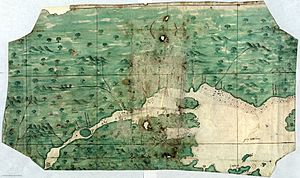
From mid-November 1535 to mid-April 1536, the French ships were frozen solid at the mouth of the St. Charles River. The ice was very thick, and snow was deep on land. To make things worse, scurvy broke out among both the Iroquoians and the French. Cartier estimated 50 Iroquoians died. Domagaya, one of the Iroquoians, told Cartier about a special drink made from a tree called annedda, likely Spruce beer or arbor vitae. This remedy cured scurvy and saved 85 Frenchmen. Cartier wrote that by mid-February, "out of 110 that we were, not ten were well enough to help the others." The French used a whole tree's bark in a week, and the amazing results made Cartier call it a miracle.
Ready to return to France in early May 1536, Cartier decided to bring Chief Donnacona to France. He hoped the chief could tell the King about a rich land further north called the "Kingdom of Saguenay," said to be full of gold and other treasures. After a difficult trip down the St. Lawrence and a three-week journey across the Atlantic, Cartier and his men arrived in Saint-Malo on July 15, 1536. This 14-month voyage was Cartier's most successful.
Third Voyage and Settlement Attempt (1541–1542)
On October 17, 1540, King Francis ordered Cartier to return to Canada. This time, the goal was to start a colony. However, on January 15, 1541, Jean-François de La Rocque de Roberval was named the leader of the French Canada expedition. Cartier would be his chief navigator. Roberval allowed Cartier to sail ahead with his ships while he waited for supplies.
On May 23, 1541, Cartier left Saint-Malo on his third voyage with five ships. Finding a passage to Asia was no longer the main goal. Now, they aimed to find the "Kingdom of Saguenay" and its riches, and to build a permanent settlement along the St. Lawrence River.
Cartier anchored at Stadacona and met the St. Lawrence Iroquoians again. He found their large numbers and "show of joy" concerning. So, he decided not to build his settlement there. He sailed a few kilometers upriver to a place he had seen before. He chose to settle at what is now Cap-Rouge, Quebec. The colonists landed, and the cattle that survived the journey were set free. They started a garden, planting cabbage, turnip, and lettuce seeds. This fortified settlement was named Charlesbourg-Royal. Another fort was built on a cliff above for extra protection.
The men also began collecting what they thought were diamonds and gold. But when they returned to France, these turned out to be just quartz crystals and iron pyrites. This led to a French saying: "faux comme les diamants du Canada" ("As false as Canadian diamonds"). Two ships sailed back to France on September 2 with some of these minerals.
After assigning tasks, Cartier left in longboats on September 7 to search for "Saguenay." He reached Hochelaga but bad weather and many rapids stopped him from going further up the Ottawa River.
Returning to Charlesbourg-Royal, Cartier found the situation worrying. The Iroquoians no longer visited or traded fish and game. Instead, they seemed to be watching in a threatening way. Records from the winter of 1541–1542 are scarce. It seems the Indigenous people attacked and killed about 35 settlers before the French could retreat behind their forts. Even though the native remedy cured scurvy, the settlers faced general hardship. Cartier became convinced he did not have enough men to protect his base or find the Saguenay Kingdom.
Cartier left for France in early June 1542. He met Roberval and his ships along the Newfoundland coast. Despite Roberval's request to join him back to Saguenay, Cartier secretly sailed away at night. He continued to France, still believing his ships held valuable gold and diamonds. He arrived in October, marking his last voyage. Roberval took charge at Charlesbourg-Royal, but the colony was abandoned in 1543. Disease, bad weather, and hostile natives caused the settlers to give up.
Later Life and Death
Cartier spent the rest of his life in Saint-Malo and his nearby estate. He often helped as an interpreter for Portuguese speakers. He died on September 1, 1557, at age 65, during an epidemic, possibly of typhus. He is buried in Saint-Malo Cathedral.
No permanent European settlements were made in Canada until 1605. That year, Pierre Dugua and Samuel de Champlain founded Port Royal in Acadia.
Jacques Cartier's Legacy
By finding the entrance to the St. Lawrence River on his first voyage, Cartier opened a major waterway. This allowed Europeans to explore deep into North America. He made good estimates of Canada's natural resources and its people. However, he greatly exaggerated its mineral wealth. While some of his actions toward the St. Lawrence Iroquoians were not ideal, he did try to build friendships. This was important for future French settlements.
Cartier was the first to write down the name Canada for the land along the St-Lawrence River. The name comes from the Huron–Iroquois word kanata, meaning "village." Cartier mistakenly thought it was the name for the whole new land. He used the name to describe Stadacona, the surrounding area, and the river itself. He also called the inhabitants (Iroquoians) Canadiens. Later, the name Canada referred to the small French colony there.
Cartier's special contribution was being the first European to explore the interior eastern region along the St. Lawrence River. His journeys helped France claim the territory that later became New France. His third voyage was the first recorded European attempt to settle North America since 1526.
Cartier was a very skilled explorer. He made three long voyages into dangerous, unknown waters without losing a single ship. He entered and left about 50 undiscovered harbors safely. This shows he was one of the most careful explorers of his time.
Cartier was also one of the first to officially recognize that the New World was a separate landmass from Europe and Asia.
Rediscovery of Cartier's First Colony
On August 18, 2006, Quebec Premier Jean Charest announced an exciting discovery. Canadian archaeologists found the exact location of Cartier's lost first colony, Charlesbourg-Royal. The colony was built where the Rivière du Cap Rouge meets the St. Lawrence River. They found burnt wooden remains from the mid-16th century. They also found a piece of a fancy Italian plate made between 1540 and 1550. This plate could only have belonged to a French noble in the colony, likely Jean-François de la Roque de Roberval.
This colony was the first known European settlement in modern-day Canada since the Viking village at L'Anse aux Meadows around 1000 AD. Its rediscovery is considered one of the most important finds in Canada since L'Anse aux Meadows.
Cartier's Ships
- Grande Hermine
- Built in France in 1534. Used in the 1535–1536 and 1541–1542 voyages. A replica was built in 1967 for Expo 67 in Montréal.
- Petite Hermine
- Built in France. Used in the 1535–1536 voyage. Cartier left it in the Saint-Charles River in 1536 because too many sailors had died.
- Émérillon
- Built in France. Used in the 1535–1536 and 1541–1542 voyages.
- Georges
- Built in France. Used in the 1541–1542 voyage.
- Saint-Brieux
- Built in France. Used in the 1541–1542 voyage.
Monuments and Remembrances
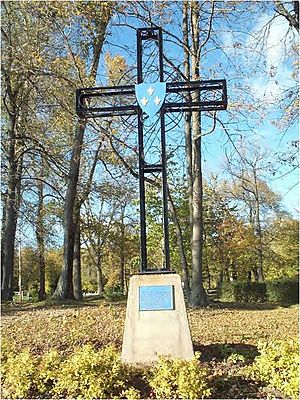
Many places and things are named after Jacques Cartier to remember his explorations:
- Jacques-Cartier River, a river in Quebec.
- Jacques-Cartier Park in Gatineau, Quebec.
- Jacques Cartier Bridge, a large bridge connecting Montreal and Longueil, Quebec.
- Jacques Cartier Provincial Park in Prince Edward Island.
- Jacques Cartier State Park in St. Lawrence County, New York.
- Place Jacques-Cartier, a famous square in Old Montreal.
- The tower of Quebec's Parliament Building is dedicated to Cartier.
- The Musee Jacques Cartier is located at the Manoir de Limoelou in Saint-Malo.
- Cartier-Brébeuf National Historic Site in Quebec City.
- Statues of Jacques Cartier can be found in Saint-Malo, Quebec City, Montreal, and Gaspé.
- Cross monuments mark his landings in Gaspé and Saint-Quentin Island.
See also
 In Spanish: Jacques Cartier para niños
In Spanish: Jacques Cartier para niños
- Jacques Cartier Strait, in Gulf of St. Lawrence
- Francis I of France, who sent Jacques Cartier to claim lands for France
- Timeline of New France history (1534 to 1607)
- Christopher Columbus


